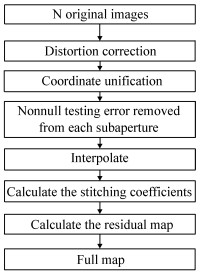| [1] |
ZHANG X J, ZHANG Z Y, LI Z L. Manufacturing and testing of 1-m class SiC aspherical mirror[J]. Proc. of SPIE, 2007, 6721:672109-5. doi: 10.1117/12.782696
|
| [2] |
MALACAL A. Optical Shop Testing[M]. New York:J.Wiley & Sons, 1992.
|
| [3] |
YANG H S, SONG J B, LEE I W, et al.. Testing of steep convex aspheric surface with a Hartmann sensor by using a CGH[J]. Opt. Express, 2006, 14(8):3247-3254. doi: 10.1364/OE.14.003247
|
| [4] |
AKIRA O, JAMES C W. Plotting errors measurement of CGH using an improved interferometric method[J]. Appl. Opt., 1984, 23(21):3905-3910. doi: 10.1364/AO.23.003905
|
| [5] |
GUO P J, YU J H. Design and certification of a null corrector to test hyperboloid convex mirror[J]. SPIE, 2006, 6150:259-263. http://proceedings.spiedigitallibrary.org/proceeding.aspx?articleid=1323209
|
| [6] |
SU P, BURGE J H, PARKS R E. Application of maximum likelihood reconstruction of subaperture data for measurement of large flat mirrors[J]. Appl. Opt., 2010, 49:21-31. doi: 10.1364/AO.49.000021
|
| [7] |
MURPH Y P, FLEIG J, FORBES G, et al.. Subaperture stitching interferometry for testing mild aspheres[J]. Proc. of SPIE, 2006, 6293:62930J. http://spie.org/x648.html?product_id=680473
|
| [8] |
SUPRANOWITZ C, McFEE C, MURPHY P. Asphere metrology using variable optical null technology[J]. Proc. SPIE, 2012, 8416:841604-5. doi: 10.1117/12.2009289
|
| [9] |
CHEN S Y, LI S Y, DAI Y F, et al.. Experimental study on subaperture testing with iterative stitching algorithm[J]. Opt. Express, 2008, 16(7):4760-4765. doi: 10.1364/OE.16.004760
|
| [10] |
TIAN C, YANG Y Y, WEI T, et al.. Nonnull interferometer simulation for aspheric testing based on ray tracing[J]. Appl. Opt., 2011, 50(20):3559-3569. doi: 10.1364/AO.50.003559
|
| [11] |
HOU X, WU F, YANG L, et al.. Experimental study on measurement of aspheric surface shape with complementary annular subaperture interferometric method[J]. Opt. Express, 2007, 15(20):12890-12899. doi: 10.1364/OE.15.012890
|
| [12] |
王孝坤.大口径离轴凸非球面系统拼接检测技术[J].中国光学, 2016, 9(1):130-136. http://www.chineseoptics.net.cn/CN/abstract/abstract9396.shtmlWANG X K. Measurement of large off axis convex asphere by systemic stitching testing method[J]. Chinese Optics, 2016, 9(1):130-136.(in Chinese) http://www.chineseoptics.net.cn/CN/abstract/abstract9396.shtml
|
| [13] |
郭福东, 唐锋, 卢云君, 等.子孔径拼接干涉的快速调整及测量[J].光学精密工程, 2017, 25(10):2683-2688. http://d.old.wanfangdata.com.cn/Periodical/gxjmgc201710019GUO F D, TANG F, LU Y J, et al.. Rapid adjustment and measurement for subaperture stitching interferometry[J]. Opt. Precision Eng., 2017, 25(10):2683-2688.(in Chinese) http://d.old.wanfangdata.com.cn/Periodical/gxjmgc201710019
|
| [14] |
张磊, 刘东, 师途, 等.光学自由曲面面形检测技术[J].中国光学, 2017, 10(3), 283-299. http://www.chineseoptics.net.cn/CN/abstract/abstract9523.shtmlZHANG L, LIU D, SHI T, et al.. Optical free-form surfaces testing technologies[J]. Chinese Optics, 2017, 10(3), 283-299.(in Chinese) http://www.chineseoptics.net.cn/CN/abstract/abstract9523.shtml
|
| [15] |
王孝坤.子孔径拼接干涉检测非球面技术的研究[D].长春: 中国科学院长春光学精密机械与物理研究所, 2008.WANG X K. Research on technique for testing of aspheric surfaces by subaperture stitching interferometry[D]. Changchun: Changchun Institute of Optics, Fine Mechanics and Physics, Chinese Academy of Sciences, 2008.(in Chinese)
|
| [16] |
闫力松, 王孝坤, 郑立功, 等.大口径反射镜子孔径拼接自检验精度分析[J].红外与激光工程, 2014, 43(6):1920-1924. doi: 10.3969/j.issn.1007-2276.2014.06.040YAN L S, WANG X K, ZHENG L G, et al.. Large-diameter reflector mirror stitching accuracy analysis based on self-test[J]. Infrared and Laser Engineering, 2014, 43(6):1920-1924.(in Chinese) doi: 10.3969/j.issn.1007-2276.2014.06.040
|






 下载:
下载:












